E8780
Epiregulin from mouse
recombinant, expressed in E. coli, lyophilized powder, suitable for cell culture
Synonym(e):
EREG
About This Item
Empfohlene Produkte
Rekombinant
expressed in E. coli
Assay
≥97% (SDS-PAGE)
Form
lyophilized powder
Mol-Gew.
predicted mol wt ~5.5 kDa
Methode(n)
cell culture | mammalian: suitable
Verunreinigungen
endotoxin, tested
UniProt-Hinterlegungsnummer
Lagertemp.
−20°C
Angaben zum Gen
mouse ... Ereg(13874)
Biochem./physiol. Wirkung
Physikalische Form
Angaben zur Herstellung
Epiregulin is a member of EGF (epidermal growth factor) family. All members of the EGF family are synthesized as transmembrane precursors and converted to soluble forms by proteolytic cleavage. Epiregulin was originally purified from the mouse fibroblast-derived tumor cell line NIH3T3/T7. Mouse epiregulin cDNA encodes a transmembrane precursorof 162 amino acids with a mature soluble form consisting of residues 56-101. Epiregulin acts like other EGF family members by binding to and activating the tyrosine kinase ErbB family receptors (ErbB1-ErbB4). Epiregulin has a broad specificity, but this ligand seems to preferentially activate heterodimeric receptor complexes. Epiregulin inhibits the growth of several epithelial tumor cells and stimulates the growth of fibroblasts and other types of cells. Its expression is upregulated in a number of carcinoma cell lines. Epiregulin is also an autocrine growth factor in human epidermal keratinocytes, and involved in the early stages of pregnancy, regulating the attachment of the blastocyst to the uterine epithelium during the implantation process.
Hinweis zur Analyse
Lagerklassenschlüssel
11 - Combustible Solids
WGK
WGK 3
Flammpunkt (°F)
Not applicable
Flammpunkt (°C)
Not applicable
Persönliche Schutzausrüstung
Eyeshields, Gloves, type N95 (US)
Analysenzertifikate (COA)
Suchen Sie nach Analysenzertifikate (COA), indem Sie die Lot-/Chargennummer des Produkts eingeben. Lot- und Chargennummern sind auf dem Produktetikett hinter den Wörtern ‘Lot’ oder ‘Batch’ (Lot oder Charge) zu finden.
Besitzen Sie dieses Produkt bereits?
In der Dokumentenbibliothek finden Sie die Dokumentation zu den Produkten, die Sie kürzlich erworben haben.
Unser Team von Wissenschaftlern verfügt über Erfahrung in allen Forschungsbereichen einschließlich Life Science, Materialwissenschaften, chemischer Synthese, Chromatographie, Analytik und vielen mehr..
Setzen Sie sich mit dem technischen Dienst in Verbindung.





